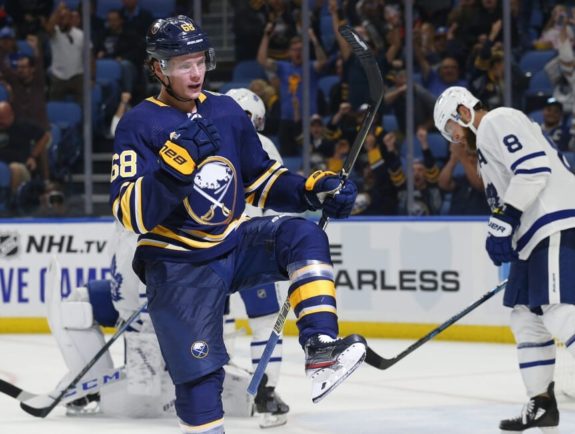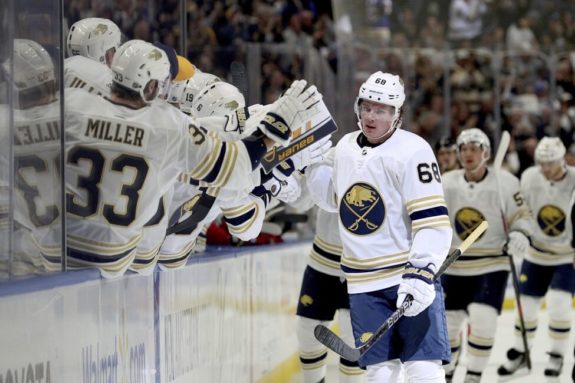Despite scoring a career-high of 28 goals this year, Sabres’ right winger Victor Olofsson had a tough end of the season – he scored just five goals from January 28th to the end of the season, and, as a result, was benched for one game in March before sitting for the entirety of a five-game stretch in April.
Because of this, Sabres GM Kevyn Adams has made it clear that Olofsson is on the trading block. However, is it the smartest idea?
Reasons For Trading Olofsson
First things first: there absolutely is (or should be) a market for Olofsson. His cap hit is more than reasonable – just one more year at a modest $4.75 million. Pure goal scorers are a commodity in today’s NHL, and Olofsson has been nothing if not consistent in that endeavor, scoring sub-20 goals only one season in his career – the COVID-19 shortened year.
It might be beneficial to Olofsson, too. After all, it’s been shown that his inconsistencies on a game-to-game basis have put him in the doghouse in the Sabres’ locker room. In a contract year, Olofsson should be looking to maximize his playing time, and mistrust from the coaches might jeopardize that opportunity.
Then there’s the case of redundancy. The Sabres certainly aren’t short of goal-scoring talent on the wings. On the right side alone, Alex Tuch and Casey Mittelstadt are listed above Olofsson on the current depth chart, and that doesn’t include up-and-coming stud Jack Quinn, who should be back within the first few months of the 2023-24 season. Middlestadt certainly doesn’t have the goal-scoring capabilities that Olofsson does, but overall, he’s a more well-rounded player.

Olofsson doesn’t exactly have space to move to the left side, either. Jeff Skinner is solidified as the team’s first-line left wing, and J.J. Peterka would more likely than not keep Olofsson out of the top-6 if he were to move.
Related: 3 Sabres That Could Step Up With Jack Quinn Injured
Olofsson’s role is challenged by prospects, too. It’s no secret that the Sabres boast one of the most prolific prospect pools in the entire NHL. As previously mentioned, Olofsson’s cap hit is at a very reasonable price. However, that price in a middle-six role is likely better moved than kept when the likes of Jiri Kulich and Isak Rosen are probably ready to make the jump to the big leagues. After this upcoming season, Matthew Savoie and Zach Benson are going to push for significant roles with the Sabres as well.
Then, there’s the matter of Olofsson’s underlying statistics. To put it lightly, they’re not what you’d want to see from a top-nine forward. Other than the six games that he played in 2018-19, his best expected goals for percentage (xGF%) came in 2019-20, where he only put up a 45.67% xGF%. This year, for the first time in his career, his even-strength shooting percentage (S%) surpassed 10%. Which, although it’s a good sign, could also mean that it’s an unsustainable figure. To play devil’s advocate, the Sabres have been notoriously leaky on defense in this span, but it’s still a yellow flag at best.
Finally, there’s the high likelihood that moving Olofsson would include an NHL-ready defenseman in return, something that the Sabres are in dire need of. Rasmus Dahlin, Owen Power, and Mattias Samuelsson make up the framework of a solid corps, but past that, the defense is shaky.
Reasons to Keep Olofsson
Now, that might seem like a lot of reasons to move Olofsson, but I still don’t think it’s in the Sabres’ best interest.
Firstly, his contract is probably appealing to other teams because of the hit and length, but that’s also a reason to keep him around This is especially with the likes of Jack Quinn missing significant time to start the year. After all, it’s not like the Sabres are tied into this deal for multiple years. The worst-case scenario for both parties is that Olofsson struggles this year and is dealt at half-retention at the trade deadline. He’s a proven commodity as a goal scorer, and coming off of a career-high in goals, the Sabres would be smart to keep him around for another trial run.
PDO is another factor in why it might be a good idea to stand pat on Olofsson. PDO is a simple metric – shooting percentage plus save percentage, usually taken at even strength. More or less, the purpose of PDO is to capture the element of luck in a player’s game. On average, PDO should equal exactly 1. A PDO above 1 indicates that a player or team might be overly lucky and due for shooting regression, while a PDO under 1 indicates that a player or team is better than they appear and will positively regress to the mean of 1.

Last season, at 5-on-5, Olofsson’s PDO was 0.962. It may seem close to 1, but in reality, anything below 0.98 is a significant indicator that the player deserved more pucks in the back of the net, considering just how many shots players take on average. In the previous two seasons, Olofsson’s PDO was again underwhelming, sitting at 0.978 and 0.985 respectively. In his rookie year, which many people believe to be his best season despite his career high in goals this year, Olofsson had a PDO of 1.02, right around where the average should be.
All of this is to say that I believe a lot of Olofsson’s downfalls have been luck-based, at least goal-scoring-wise. Underlying statistics don’t matter as much if the player is potting 30 goals on a perennial basis. Patrik Laine is a good example of that. Laine has never had a season with an xGF% of above 50%, and yet no one talks about it because he’s so good at putting pucks in the back of the net. Olofsson’s underlying metrics throughout his career are actually better than Laine’s, which, although they still aren’t good, could be evened out by average PDO, which likely would have resulted in another five to 10 goals this past season. If Olofsson were to put up that extra five to 10 goals, there wouldn’t be talks of him being on the trading block at all.
Parting Thoughts
By quantity alone, the reasons to move Olofsson far outweigh the reasons not to. However, with that said, there is quantitative reason for fans and the Sabres’ front office alike to keep Olofsson around – at least until the trade deadline. It is possible that his PDO continues to dip below 1, and that he’s just a player with below-average finishing ability at even strength. Yet, I’m of the opinion that he didn’t just stumble upon 28 goals by accident, and that there certainly is more in the tank for Olofsson moving forward.
